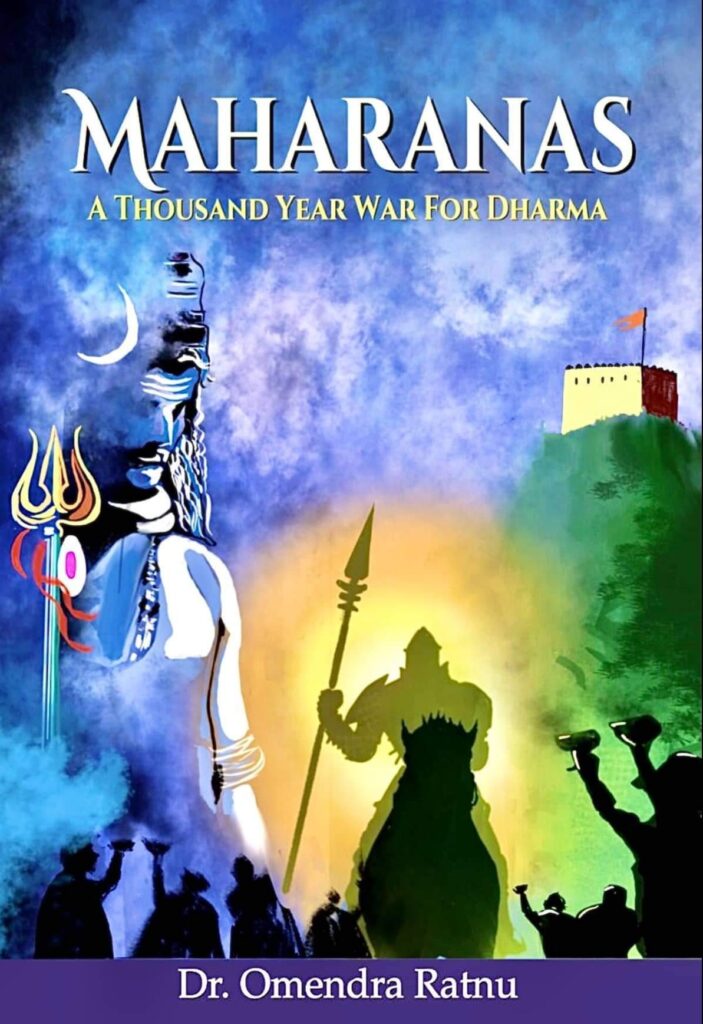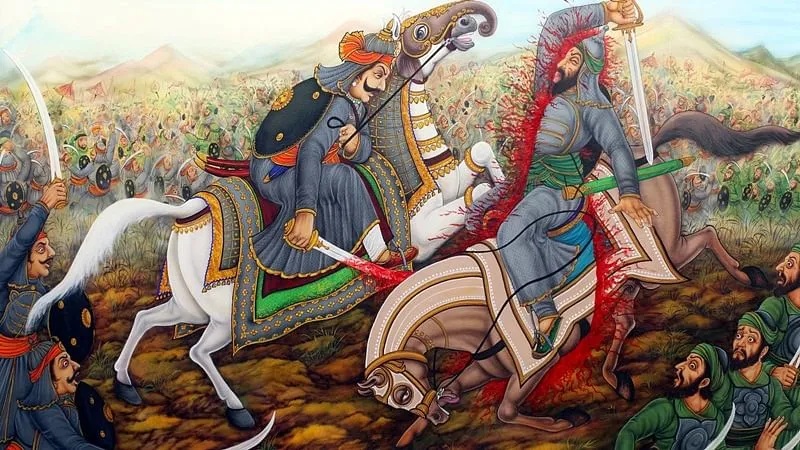
Any Islamist apologist or pseudo-liberal historians in Bharat who claim that the invading Muslim horde from the hot deserts of Arabia and later from Central Asia could have easily converted the Sanatanis of Bharat to Islam are lying. Arguments such as Hindus are still the majority in India because Islam is a religion of peace and those who converted to Islam because of social injustices is a lie and the book “Maharanas’s, A Thousand Year War For Dharma” is a testament to counter all the lies.
The book, “Maharanas’s, A Thousand Year War For Dharma” written by Dr Omendra Ratnu proudly chronicles the history of the Sisodiya Rajputs who stood guard, lost countless generations of their sons and daughters in protecting Maa Bharati and resisted one thousand years of Ghazwa e Hind by a marauding, ruthless and bloodthirsty Musalman.
This book at best can only be described as a synopsis of the one thousand-year illustrious history of the proud legacy of the Rajputs of Mewar or Mewad and also it would be impossible to write about all the Maharanas as many left a distinguished legacy that would require volumes. As one reads this book it is evident that the level of self-sacrifice the Sisodiya Rajputs made is unparalleled in the history of Bharatvarsha because, without divine power (Page 70), it would be impossible for just one lineage to keep the resistance alive for one thousand years.
The book is steeped in the Indic way of storytelling by Dr Ratnu and reads like our folk tale and stories that were told to us by our grandmothers
Also, it is impossible to comprehend how one family and the residents of one kingdom endure so many hardships and suffering, yet they remain defiant and relentless to fight for Dharma. It is amazing that kings after kings who were outnumbered and outwitted in the fight stood firm against the aggression of Islam (Page 71).
Perhaps the answer to why the Maharanas were so blessed is because of their humility. After the loss of Chittorghar which was the impenetrable bastion of the Rajputs, the Sisodias who were known as Rawal after their founder, the great Bapa Rawal, they decided they will no longer be kings but stewards or caretakers and the kings of Mewar will be known as Rana and the true king will be their deity Eklingji, an avatar of Lord Shiva. This shows a remarkable shift in their human consciousness as kings became servants of Mahadev and became great warriors by deed (page 73).
The book is steeped in the Indic way of storytelling by Dr Ratnu and reads like our folk tale and stories that were told to us by our grandmothers and the author felt three particular instances mentioned in this book be told.

The first one is the story of Raja Dahir Sen’s daughters who were taken as sex slaves, something unheard of in Sanatan Bharat. The two daughters of Dahir were named Surya Devi and Premela Devi who tricked the Caliph Al Hajjaj of Bhagdahd into believing that Mohammed Bin Qasim had killed their father and brothers had violated their honor and then presented them to him. The enraged Caliph had Bin Qasim wrapped and stitched in an oxen hide and the Mlechcha suffocated and died. The brave Devi were then buried alive in a wall, but they kept their honor and with their intelligence took revenge (Page 35).
The second story is that of Bhisham of Rajasthan, Prince Choonda the eldest son of Maharana Lakshya Singh Lakha who forsook his claim to the throne for his father. To ensure there will be no future animosity, Choonda swore an oath that none of his descendants will ever lay claim to the throne and that promise was kept for over five hundred years by his sons and grandsons who always fought for Mewar selflessly. There is no account of such self-sacrifice and loyalty in the entire history of Bharatvarsha.
The third story that must be told is that of Panna Dhai (foster mother), who sacrificed her own son to save prince Uday Singh who will father perhaps the most valiant Rajput King Maharana Pratap Singh who is regarded as त्याग का प्रतिबिम्ब, a beacon of sacrifice and Kshatriya Dharma. If Panna who was not a Rajput but a Gurjar had not saved the infant Uday Singh, history would be different and having a non-Rajput as a foster mother shows social cohesion amongst Hindus (Page 148).
Dr Ratnu in his book had to cover a lot of ground and in that process, he has also managed to successfully dispel many historical inaccuracies and fallacies that have plagued our history books for decades to make us feel ashamed and subservient. One of the most important facets of this book is, that whenever we were attacked by the mindless death cult described in ancient Rajasthani as Asuras and Mlechchhas (page 45), all Hindus irrespective of Varna, fought alongside these Dharma Rakshak Devapurshas.
Dr Ratnu has managed to successfully dispel many historical inaccuracies and fallacies that have plagued our history books for decades to make us feel ashamed and subservient.

However, under the cloak of secularism and obscurantist narration of our liberal academia and Bollywood famous for demeaning our history and culture, the glorious resistance of Rajputs was hidden from us and we were fed lies about “one thousand years of slavery” when we fought and resisted all along. How many of us had even heard of Rana Hammir Singh who had lost everything but somehow through divine intervention managed to win Chittor back and also he had imprisoned Mohammad Bin Tughlaq and extolled massive penalties from the Delhi Sultanate. Rana Lakha took Firoz Bin Tughlaq prisoner and again the Muslims were forced to pay reparations.
Who knew that Rana Kumbha had fought fifty-six battles and never lost, however, in our schools, we are taught about Alexzander of Macedon and Julius Caesar. Also, Kumbha defeated and took prisoner Sultan Mahmud Khilji of Malwa and made him pay reparation. Rana Kumbha was so successful, that his reign and influence reached Afghanistan and East of Malwa. Rana Sanga fought one hundred battles and defeated Ibrahim Lodhi twice. But these facts were kept from us.
How many of us were told lies about the Delhi Sultanate that they ruled vast swaths of land in India, but in reality, they ruled just a few hundred kilometers of Delhi and survived only on war economy by plundering. The fact is after the defeat of Prithviraj Chauhan in the Second Battle of Tarain by Mohammad Ghori, infighting led to the assassination and rebellion of twenty-five rulers in rapid succession of the Delhi Sultanate. It also speaks of the volume of unethical practices when it comes to ruling. Almost all Islamic empires suffered from succession planning and Pakistan as an Islamic State is a prime example because of the absence of Dharma and the presence of only greed and lust.
Christian missionaries, Marxist historians, and promoters of the Ganga Jamuna Tehzeeb gave an entire civilization an inferiority complex and for a long time had the upper hand in portraying Islam as a religion of peace and also as a major contributor to our society and culture. In reality, all the Islamic invaders were only known for their abject violence and debauchery.
History is written by the victors and in Bharat, history has been written by Islamic apologists and leftists who conveniently erased Bappa Rawal from our memories and how for five hundred years, the Arab and Turkik invaders were never allowed to enter our motherland. This part of history is never told to us because any reference that glorifies Sanatana Dharma in post-independence India will give Hindus revivalist feelings of our great past.
Dharmo Rakshati Rakshita, Har Har Mahadav!
(The author is a freelance writer and has published articles on defence and strategic affairs. He tweets @LaxmanShriram78. Excerpts from the book have been slightly paraphrased for the sake of continuity)
Book: Maharanas’s, A Thousand Year War For Dharma
Author: Omendra Ratnu
Publishers: Prabhat Books
Price (Hardcover):
SW Ratings: ****
Balaji is a freelance writer with an MA in History and Political science and has published articles on defence and strategic affairs and book reviews. He tweets @LaxmanShriram78. Views expressed are the author’s own.

I can’t wait to get hold of this book. I have seen Dr. Ratnu talk on different shows on this topic and just listening to him share the details of Jauhar and Shaka like acts gets the blood boiling. I can only imagine how powerful those pages are going to be once I get my hands on his work!
Thank you for sharing your insights and adding to the excitement 🙏